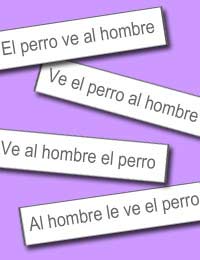Personal a in Spanish

Spanish word order tends to be quite fluid. Because of this, an extra 'pointer' is needed to make clear whether the person is the subject of the verb (in other words, the person who does the action) or the direct object of the verb (i.e. the person who is seen, helped, heard etc.). This little marker is otherwise known as the 'personal a'. It simply means the use of 'a' before the direct object if the direct object is a person.
There is no literal meaning, it is just an indicator to avoid confusion. In many ways, it's a marking out of human direct objects and giving them a special distinction. (Other languages do this as well.) In particular, the personal 'a' is never omitted before a direct object which is a personal name or title - Uncle Pepe, Professor Gomez.
These are examples of how the personal a would be used:
- Vi a José
- I saw José
- Pepe llama a Sergio
- Pepe calls Sergio
Nadie and Quien
The same principle applies with these two words:- No vio a nadie.
- He/She/You (formal) saw nobody.
- Note the different meaning without the 'a':
- No vio nadie
- Nobody saw.
- It's the same story with quién -
- ¿Quién vió?
- Who saw?
- ¿A quién vió?
- Who did he/she/you (formal) see?
Note that, to make the meaning absolutely clear, the personal 'a' is sometimes also used even if the direct object is an animal.
So: Atacó el perro el gato is ambiguous - it could mean the dog attacked the cat, or vice versa.
But: Atacó el perro al gato ( a and el having contracted in this sentence to form al) Thanks to the personal a, this sentence can only mean that the dog attacked the cat.
Additionally, this construction is sometimes used in front of animals, towns and countries to personalise them. In many cases, with animals it depends on the extent to which you want to humanise the creature.
More Example Sentences
Have a look at the following:- Todavía no conozco al novio de mi hermana.
- I still don't know (or haven't met) my sister's boyfriend.
- ¿Conoces a María?
- Do you know Mary?
- ¿A quién viste?
- Who(m) did you see?
- No vi a nadie.
- I didn't see anybody.
Gustar and 'Back to Front' Verbs
There are a number of Spanish verbs which work 'back to front' to their English equivalents. The subject in English becomes the direct object in Spanish. So that 'My son likes computers', which sounds perfectly natural to the English ear, becomes 'Computers please my son' (literal translation of the Spanish). In such cases, the personal a is often used for emphasis.So:
- A mi hijo le gustan los ordenadores
- My son likes computers.
- A mí no me gusta el trabajo
- I don't like work.
- Me apetece - I feel like
- Me duele - It hurts
- Me encanta - I love (things rather than people)
- Me interesa - I am interested in
Querer
Have a look at these two sentences, and see the difference the personal 'a' makes:- Quiere una secretaria.
- He (or indeed she) wants a secretary.
- Quiere a una secretaria.
- He (or indeed she) loves a secretary.
- How to Learn Future Tense in Spanish
- Spanish Words to Watch Out For
- The Subjunctive in Spanish
- Irregular Verbs in Spanish
- The Past Imperfect Tense in Spanish
- The Conditional Tense in Spanish
- The Past Preterite Tense in Spanish
- Personal Pronouns in Spanish
- The Infinitive in Spanish
- Ser and Estar in Spanish
- The Present Tense in Spanish
- Por and para in Spanish
- Accents in Spanish
- Adjectives in Spanish
- Gender of Nouns in Spanish


Re: Spanish Phrases for Hotels
Hi, I work in a hotel in the US. I'm trying to learn phrases in Spanish to speak to my Spanish speaking guests. Phrases…
Re: Spanish Numbers Days and Months
How do you say the twelfth month in Spanish. Not the month itself. Just that phrase
Re: Personal Pronouns in Spanish
How come vosotros isn't in the subject pronouns?
Re: The Influence of Spanish on English
I have found this website very useful and the present article has helped me a lot in understanding the influence of…
Re: The Past Preterite Tense in Spanish
magb123 - Your Question:You have a typo on 'ser'. The first person singular is 'fui' not 'fu'Our Respo
Re: The Past Preterite Tense in Spanish
you have a typo on 'ser'. The first person singular is 'fui' not 'fu'
Re: Spanish Numbers Days and Months
I´m spanish, i could give custom classes to anyone interested.
Re: The Past Preterite Tense in Spanish
Some typos on this otherwise excellent page: "Ponder" for poder and "fu" for fui. You need a proofreader.
Re: Colours in Spanish and How They Are Used
i really found this site very helpful as a college student! thanks